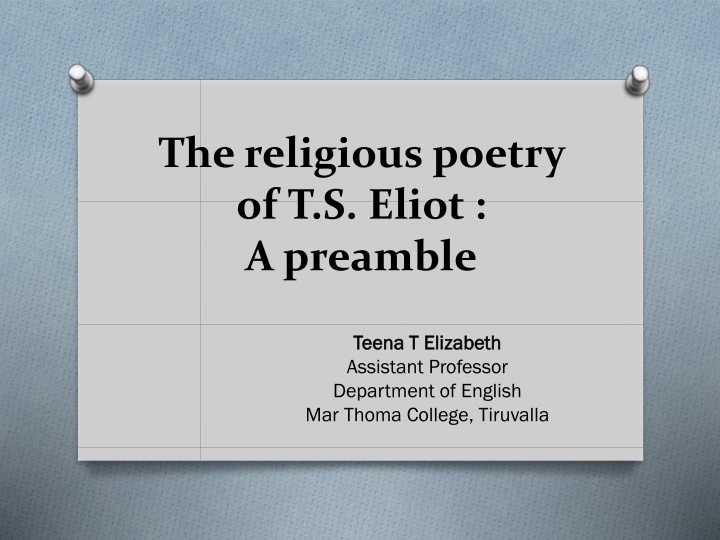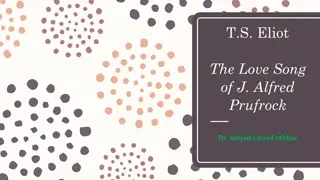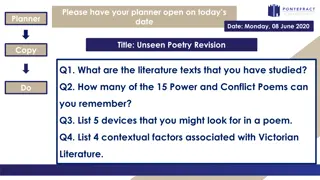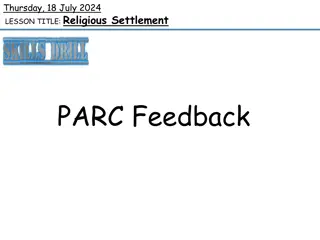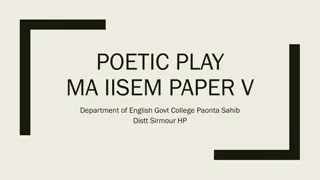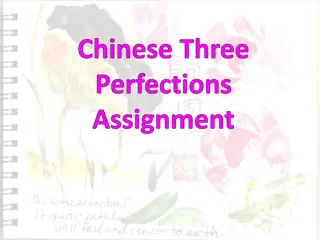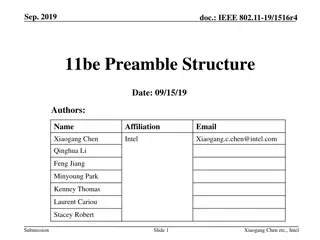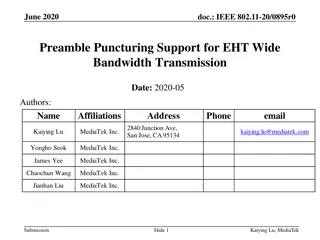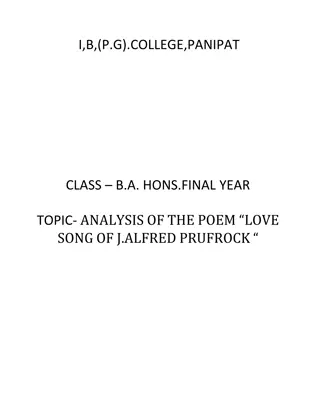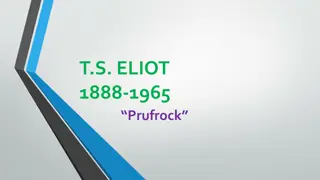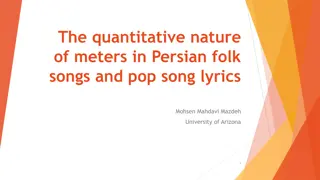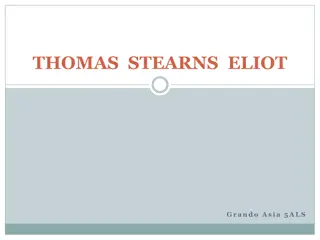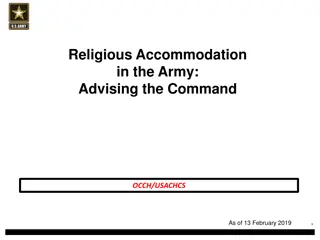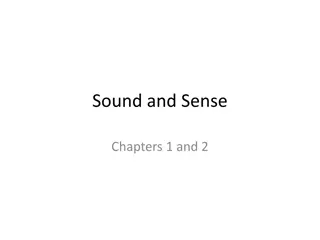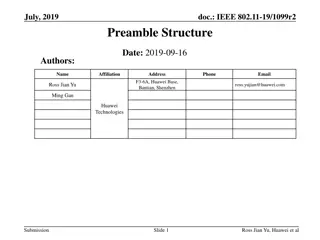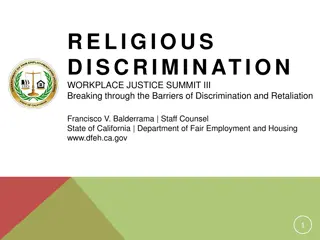Exploring the Religious Poetry of T.S. Eliot: A Preamble
Thomas Stearns Eliot, a renowned American-English poet, playwright, and literary critic, is celebrated for revitalizing English poetry through his innovative style and critical essays. Influenced by various sources like Indian thought, F.H. Bradley's philosophy, and Christianity, Eliot's work can be divided into phases before and after his conversion, showcasing themes of communication failure, estrangement, and isolation.
Download Presentation

Please find below an Image/Link to download the presentation.
The content on the website is provided AS IS for your information and personal use only. It may not be sold, licensed, or shared on other websites without obtaining consent from the author.If you encounter any issues during the download, it is possible that the publisher has removed the file from their server.
You are allowed to download the files provided on this website for personal or commercial use, subject to the condition that they are used lawfully. All files are the property of their respective owners.
The content on the website is provided AS IS for your information and personal use only. It may not be sold, licensed, or shared on other websites without obtaining consent from the author.
E N D
Presentation Transcript
The religious poetry of T.S. Eliot : A preamble Teena Teena T Elizabeth T Elizabeth Assistant Professor Department of English Mar Thoma College, Tiruvalla
Thomas Stearns Eliot O American-English poet, playwright, literary critic, and editor, a leader of the modernist movement in poetry O One of the most distinguished literary figures of the 20th century O Eliot exercised a strong influence on Anglo- American culture from the 1920s until late in the century.
O His experiments in diction, style, and versification revitalized English poetry O He shattered old orthodoxies and erected new ones through his critical essays O In 1948 he was awarded both the Order of Merit and the Nobel Prize for Literature.
O Major Influences: The most conspicuous influences on his works are: the family, Donne and the Metaphysicals and the Jacobeans, the French Symbolists, Dante, Irving Babbitt, Santayana, Josiah Royce, F. H. Bradley, Bergson, German phenomenologists, Ezra Pound, T. E. Hulme, Wyndham Lewis, Middleton Murry, R my de Gourmont, The Criterion circles, primitive ritual and Christianity, and the Indian Scriptures
Out of all these influences we can pin down three significant influences: Indian thought The philosophy of F. H. Bradley Christianity Though it is possible to ascertain numerous influences on Eliot and his writings Indian, Bradleyean, and Christian thought predominate
O Eliots poems can be seen as belonging to two phases: Before conversion After conversion
Before conversion poems dealt with themes that include: O Failure of communication O Estrangement between man and woman O Individual s isolation Till The Waste Land, Eliot s poetry is richly furnished with images of the sordid, the disgusting and the depressing and with personalities of similar quality
O The Waste Land and The Hollow Men are titles indicating the grounds of alienation O The Waste Land is a grand consummation of the themes, techniques and styles that Eliot had been developing in his earlier stage. O The Hollow Men is at once an epilogue to the earlier stage and a prologue to the new stage in his career This is the way the world ends Not with a bang but a whimper. O The Hollow Men provides a link between the despair of The Waste Land and the new-found faith expressed in The Ash Wednesday
The distinctive features of Eliots earlier poetry : O Derived impetus from French symbolists and English imagists and combined images in a non- discursive, non-logical , often purely intuitive order O Developed a new stock of images from contemporary life O Metrical influence of the later Elizabethans enabled him to stretch, contract and distort blank verse to give it the vitality and flexibility of living speech.
O The new stage is marked by Eliots entry into the Church of England O The difference in position is produced by a development rather than a break from the earlier stage O The title Ash Wednesday itself indicates the position of the poet in the new phase of his career that emerged after the publication of The Hollow Men O His outlook starts to mature as he finds a way of living in the world through his developing Christian faith
The predicament of the modern man in ascending spirituality and search for reality is found in Eliot s Ash Wednesday (1930), A Song for Simeon (1928), Animula (1929), Mariana (1930) and Choruses from the Rock (1934) Man s struggle to retain their spiritual identity in an age increasingly devoted to the secular remedies can be identified as the major concern of these poems grouped together as Ariel poems.
O After this , Eliot returned to the poetry of religious meditation O In the Four Quartets , the religious poetry achieves a contemplative depth O A quartet is a piece written for four stringed instruments, divided into five sections called movements. O The movements are linked by a recurring theme or themes O All the four quartets share common structural features and are concerned with related themes
O The common theme is religious O The poet names the poems after four places which were important to him in his own personal history: Burnt Norton a large country house in Gloucestershire, where Eliot stayed during the summer of 1934 East Coker- a small village in Somerset, the ancestral village of the poet Dry Salvages a small group of rocks off the north coast of cape Ann, where Eliot s forbears had originally settled Little Gidding a small country church in Huntingdonshire where Eliot appears to have made a pilgrimage to
O Throughout the four poems we find allusions to contemporary events O A considerable number of words, images, phrases and ideas recur through the whole sequence of the poems O The Four Quartets have proved themselves as a valuable record of modern religious experience O It is a poet s attempt to enlighten and justify his whole spiritual climate O The Quartets are difficult poems owing to the concentration with which Eliot s belief is expressed, developed and insisted upon
O Each of the four poems is coloured by a particular element : In Burnt Norton- Air In East Coker - Earth In The Dry Salvages- Water In Little Gidding- Fire We encounter philosophical meditations on varied topics as we go through the four poems. Burnt Norton is the poet s reaction to an experience of spiritual illumination that was occasioned by a visit to the garden of the house. The experience stood out from the dull sequence of ordinary life. The poem consists of various reflections on the meaning of such experiences.
East Coker contains a number of themes interwoven into a meditation on the passage of time. The poet s personal reflections on his own arrival at middle age, and his family s history are central. The poem is deeply personal with a self-exposure. The religious significances are more explicit. The focus is on a famous passage on the nature of language and poetry. Out of darkness, Eliot offers a solution: "I said to my soul, be still, and wait without hope."
The Dry Salvages provides a symbolic significance of the sea-scape contrasted with the river scene. The river and sea images convey aspects of human existence in time. We also have a harsh and painful portrayal of the human condition and a thoroughly unequivocal expression of dependence upon the divine grace. It strives to contain opposites: "The past and future / Are conquered, and reconciled."
In Little Gidding, the themes that were dealt with in the earlier poems are gathered and woven together but with a new confidence and spiritual exaltation to an assertion of the possibility of the total transfiguration and supernaturalizing of life. This is the brilliantly musical of all the four poems. The beginning of the Quartets ("Houses / Are removed, destroyed") had become a violent everyday experience. the Quartets end with an affirmation of Julian of Norwich: "All shall be well and / All manner of thing shall be well."
O Four Quartets is thus a record of his spiritual journey and the underlying argument is spiritual progress O The divine-human encounter in the poem is at the level of mediation
